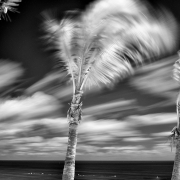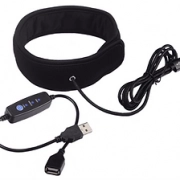Gear Review – Variable Infrared Filter
I have been playing with a variable infrared filter of late. I came across it on Amazon and it intrigued me. At first, I thought it was one of the many mislabeled items on Amazon, but I clicked on the item to see what it all about.
This is a circular glass filter, with an infrared range of 530 nm – 750 nm under the brand name Fotga. It is available in various filter sizes ranging 46-82 mm. There is an assortment of reviews, ranging from good to lousy. Amazon reviews don’t often influence whether I try something out or not so for the whopping price of under $30 I didn’t have much to lose. I could always return it if it was a total failure.
The filter functions like a variable neutral density filter. It has markings with the range of 530 nm to 750 nm. As I mostly shoot 530 nm to 720nm this filter fit my purpose. If it worked well, it would eliminate the filter swapping dance during a shoot.
It’s an interesting concept of an infrared filter. It appears to be made up of two polarizing filters and a long pass red filter.
Out of the Box
The filter is solidly built. Good finish and fit.
The filter markings are evenly spaced which would make you think that each line is a 10 nm increment from 530 nm to 750 nm wavelength (but it’s not). It would have been helpful to set the marks at the specific wavelengths advertised – 530 to 650/680/720/750. So, does this mean that the two line marks to the left of 750nm identify the point where the filter is at 720 nm and 680 nm? Which lines identify 550/590/630/650? There are eight lines and nine dots. It’s not clear at all which makes it difficult to use a white balance preset. Yes, I can set a white balance as I shoot but that actually defeats the purpose of saving time swapping filters. Yes, I can set the white balance when I process but I prefer to set it in camera.


Test Setup
The following are tests using the variable infrared filter and also using fixed wavelength filters, specifically 550, 680 and 720nm for comparison. A Nikon D800 full-frame camera converted to full-spectrum infrared was used. The day consisted of heavy overcast with very brief periods of bright sunshine.
The raw files were downloaded to Nikon’s NX Studio. White balance was set on each image using the grey point dropper tool on the grass area and exported as a 16-bit Tiff. Prior to pulling the images into Adobe Camera Raw, they were sharpened in Topaz Sharpen AI. Basic adjustments were applied in ACR and synced across all of the images in the test. No channel swap or further processing was performed for this review.
Test Results
Using the variable infrared filter, an image was taken starting at the 530 nm point. The filter was then moved up to the subsequent line marker and a shot was taken.
Variable IR filter @ 530 nm mark.

Variable IR filter @ first line after the 530 nm mark.

Variable IR filter @ second line after 530 nm mark.

Variable IR filter @ third line after 530 nm mark.

Variable IR filter @ fourth line after 530 nm mark.

Variable IR filter @ fifth line after 530 nm mark.

Variable IR filter @ sixth line after 530 nm mark.

Variable IR filter @ seventh line after 530 nm mark.

Variable IR filter @ eighth line after 530 nm mark.

Variable IR filter @ 750 nm mark.

Comparison Test
The following are comparisons of the variable infrared filter and fixed wavelength filters, specifically 550, 680 and 720nm. It’s a best guess estimate as to the actual wavelength the filter was dialed in with the filter lines.
Using the fixed 550 nm filter.

Approximate 550 nm from the variable infrared:

Using the fixed 680 nm filter:

Variable infrared, second line mark to the left of 750 nm.

Using the fixed 720 nm filter:

Variable infrared, first line mark to the left of 750 nm.

Summary
Overall, I am very surprised the filter performed as well as it did. For the price, it’s a nice little filter to play with. You do need to be careful and line up the line markers with the dot or banding may occur. I will most likely use the 680 nm white balance preset when I shoot with this filter and then fine tune the white balance in post. A full-spectrum infrared camera is recommended when using this filter. Fotga Variable Infrared Filter
Pros
- No need to swap filters so less to carry on a shoot.
- Solidly made of glass and metal.
Cons
- Difficult to know exactly which wavelength you’re shooting with unless you’re on the 530 nm or 750 nm marker.
- Banding may occur if you don’t line up the marks.
Below, a processed image shot with the Fotga variable infrared filter.

© Silvana Della Camera
To learn about upcoming workshops and tips on photography, consider subscribing to my website.
Taking photos and want to make them more compelling?
Art isn’t just for walls. Art is also to hold in one’s hands.
 Silvana Della Camera
Silvana Della Camera
 Silvana Della Camera
Silvana Della Camera

 Silvana Della Camera
Silvana Della Camera


 Silvana Della Camera
Silvana Della Camera
Leave a Reply
Want to join the discussion?Feel free to contribute!